TRIANGLE
A triangle is a polygon with three angles and three sides. It is one of the basic shapes in geometry. A triangle with sides A, B, and C is denoted by Δ ABC.
Properties of Triangle :
The sum of the angles of a triangle is 180°.
The sum of any two sides of a triangle is greater than the third side.
Types of Triangle :
1. Right-Angle Triangle :
Pythagoras Theorem : In a Right-angle Triangle.
(Hypotenuse)2 = (Base)2 + (Height)2.
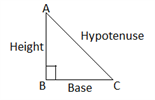
Area of a Right-angle triangle : 
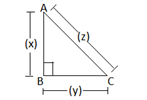
Perimeter of a triangle : Sum of all sides = (x + y + z)
2. Equilateral Triangle :
If each side and each angle(i.e 60°) of a Triangle is equal, then it is called an Equilateral Triangle.

Formulas :
Area of Equilateral Triangle : √3/4 × (side)2 = √3/4 × (a)2
Perimeter of Equilateral Triangle : 3 × side = 3 × a = 3a
3. Any Triangle :

Formula :
Area of Any Triangle :  [where S = Semi Perimeter,
[where S = Semi Perimeter, ]
]
QUADRILATERAL
A Quadrilateral is a Polygon with four sides and four angles. The sum of all angles is 360°.
Types of Quadrilateral :
1. Square : A Quadrilateral, in which all sides are equal and opposite sides are parallel to each other and each angle is equal and 90°, called a Square.
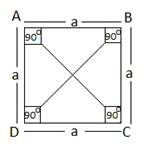
ABCD is a square
AB = BC = CD = DA = a

Diagonal, AC = BD
Formulas :
Area of a Square : (side)2 = a2.
Perimeter of a Square : Sum of all sides = 4a.
Diagonal : √(a2 + a2) = a.√2
2. Rectangle : A Quadrilateral, in which opposite sides are equal and parallel and angle is 90°, called a Rectangle.
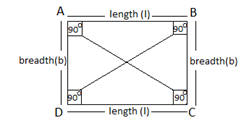
ABCD is a Rectangle
AB = DC = length = l
AD = BC = breadth = b

Diagonal, AC = BD
Formulas :
Area of a Rectangle : (length × breadth) = l × b
Perimeter of a Rectangle : Sum of all sides = l+b+l+b = 2l+2b = 2(l+b).
Diagonal : √ (l2 + b2)
3. Parallelogram : A Quadrilateral, in which opposite sides are equal and parallel, but the angles are not 90°, called a Parallelogram.
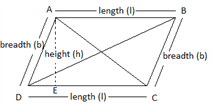
ABCD is a Parallelogram
AB = CD = length = l (base)
AD = BC = breadth = b
AE = height = h
Diagonals, AC ≠ BD
Formulas :
Area of a Parallelogram : (base × height) = (l × h).
Perimeter of a Parallelogram : 2 × (length + breadth) = 2 × l × b.
Adjacent angle of A is B & D then
4. Rhombus : A Quadrilateral, in which all sides are equal and parallel, but the angles are not 90°, called a Rhombus.
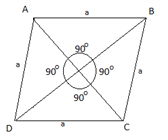
ABCD is a Rhombus
Let Diagonals AC = d1 and BD = d2
Formula :
Area of a Rhombus : (AC × BD)/2 = (d1 × d2)/2
5. Trapezium : A Quadrilateral, in which two sides are parallel, called a Trapezium.
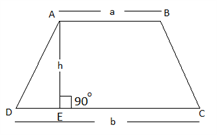
ABCD is a Trapezium
AB and CD are parallel sides and AE is distance between them
Let AB = a, CD = b and AE = h, then
Formula :
Area of a Trapezium : 1/2 × (sum of parallel side × distance between them) = 1/2 × (a + b) × h.
CIRCLE
A Circle is a round shaped figure that has no corners or edges and whose boundary consists of points equidistant from a fixed point (the centre).

This is a Circle, AO or OB = radius = r (let)
Then Diameter, AB = 2r
Formulas :
Area of a Circle : ∏r2, where ∏ = 22/7
Circumference of a Circle : 2∏r
Semi-Circle :
Area : 1/2 ∏r2
Circumference : 2∏r/2 + 2r = ∏r + 2r = r (∏ + 2)
Length of an arc AB : 2∏r/2 = ∏r
Sectorial Area of a Circle :
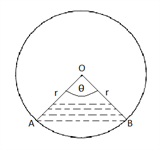
Let, then
then
Area = ∏r2 × θ/360°
Length of an arc = 2∏r × θ/360°
Circumference of AOB = 2∏r × θ/360° + 2r